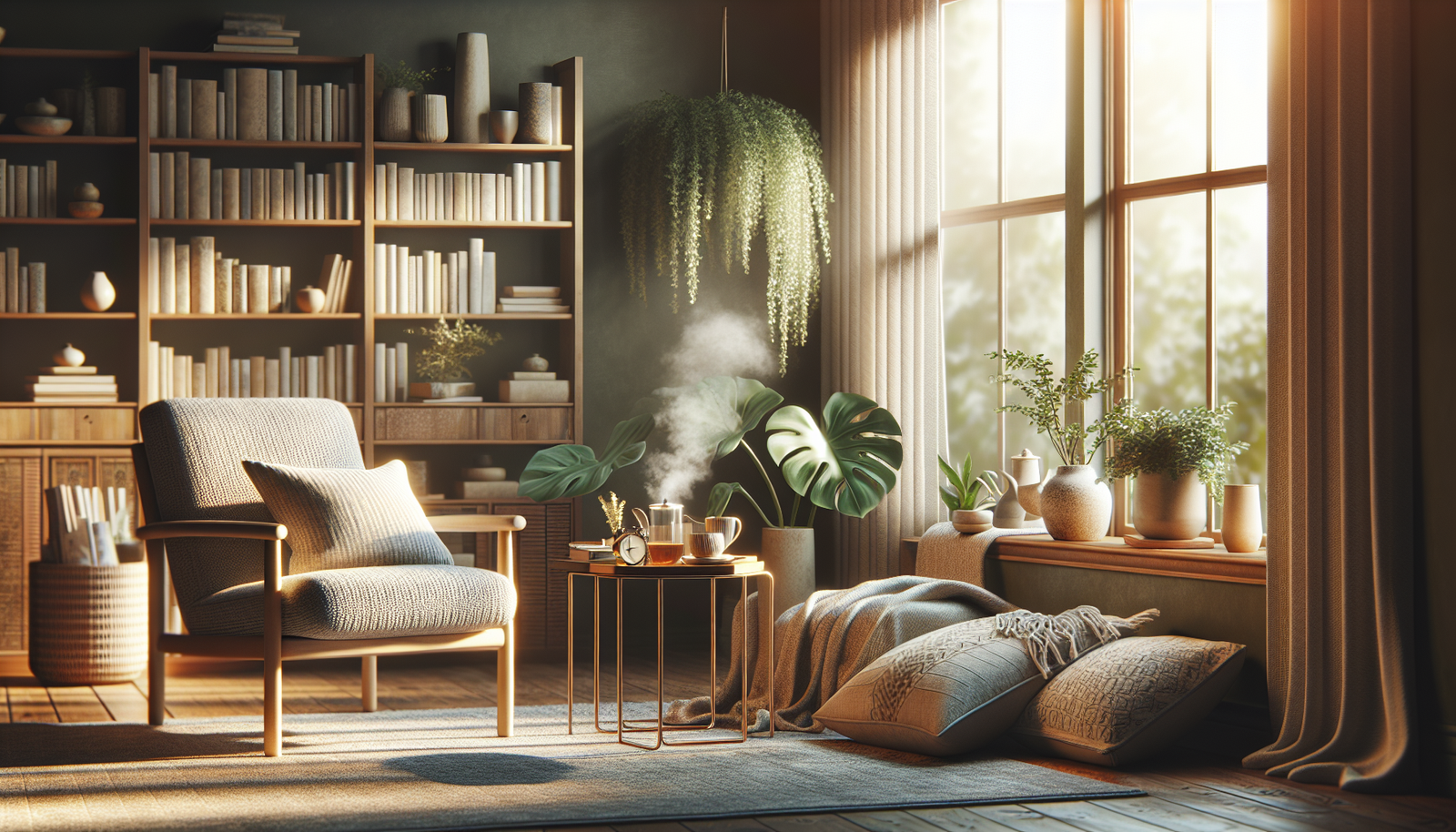Creating Your Sanctuary: Tips for a Relaxing Home Environment
Creating Your Sanctuary: Tips for a Relaxing Home Environment
Creating a sanctuary in your home is essential for promoting relaxation, reducing stress, and enhancing overall well-being. A thoughtfully designed space allows you to escape from the outside world’s chaos, providing comfort, peace, and rejuvenation. Below are key tips to help you create an inviting and serene home environment.
1. Assess Your Space
Before diving into changes, assess your current space. Identify areas that cause stress or discomfort and consider how you interact with various rooms throughout your home. Does your living room feel cramped? Is your bedroom too cluttered? Taking stock is the first step toward transformation.
1.1 Identify Zones
Break your home into zones based on functionality. For example, consider creating dedicated spaces for relaxation, work, socialization, and hobbies. Each zone can then be tailored for specific activities, promoting peace and productivity.
2. Choose Calming Colors
Color psychology plays a significant role in how we feel within a space. Soft, muted colors often promote calmness and relaxation. Consider incorporating the following shades:
- Blue: Known for its calming effects, blue reduces stress and creates a serene atmosphere.
- Green: Associated with nature, green helps ground you and rejuvenates your mood.
- Soft Neutrals: Beige, soft grays, and pastel hues can create a warm, inviting backdrop that promotes relaxation.
2.1 Accent Colors
Once you’ve established your base color palette, add accents that create visual interest without overwhelming the senses. Consider soft teal cushions, dusty rose décor, or gentle earthy tones that harmonize with the primary colors you’ve chosen.
3. Invest in Furniture
Comfortable furniture is essential in creating a relaxing environment. Choose pieces that not only serve a functional purpose but also invite you to unwind.
3.1 Cozy Seating
Invest in plush sofas, reclining chairs, or oversized bean bags that encourage relaxation. Layer with soft throws and pillows to enhance comfort. Remember, your seating should make you feel cradled and supported.
3.2 Functional and Comfortable Beds
Prioritize your bedroom by selecting a high-quality mattress that meets your comfort needs. Layer your bed with soft sheets and a cozy duvet that encourage restful sleep.
4. Utilize Natural Light
Natural light can drastically affect mood and energy levels. Keep windows unobstructed, and maximize natural light to create a warm, inviting space.
4.1 Window Treatments
Choose light, airy curtains or blinds that allow ample sunlight while providing privacy. Consider sheer fabrics that diffuse light beautifully into your home.
4.2 Mirrors for Reflection
Incorporate mirrors strategically to reflect light and create an illusion of more space. A well-placed mirror can amplify sunlight and brighten up darker corners of your room.
5. Incorporate Nature
Bringing the outdoors inside can foster a sense of tranquility and connection to nature. Plants and natural elements can improve air quality and promote feelings of well-being.
5.1 Houseplants
Choose low-maintenance plants such as snake plants, pothos, or peace lilies. These plants not only improve air quality but also add a touch of vitality to your home.
5.2 Natural Materials
Incorporate natural materials such as wood, stone, and cotton in your décor choices. Wooden furniture, stone countertops, and cotton textiles create a harmonious atmosphere that feels grounded and welcoming.
6. Prioritize Cleanliness
A cluttered space can lead to a cluttered mind. Maintaining cleanliness is crucial to fostering a relaxed environment.
6.1 Adopt Minimalism
Consider embracing a minimalist lifestyle by reducing excess items. Keep only what you genuinely need and love. This simplification promotes peace and clarity.
6.2 Regular Cleaning Routine
Establish a regular cleaning routine that keeps your space fresh. Incorporate deep cleaning sessions monthly to declutter and organize areas that often get neglected.
7. Create a Relaxation Zone
Setting aside a specific area in your home purely for relaxation can significantly enhance your overall well-being.
7.1 Meditative Space
Designate a corner for meditation or mindfulness activities. Add a comfortable cushion, calming artwork, and perhaps a small fountain to create a serene environment.
7.2 Reading Nook
Create a cozy reading nook with a comfortable chair, a small bookshelf, and soft lighting. This space should be a retreat for you to curl up with your favorite book and escape into a world of fiction.
8. Soft Lighting
Lighting plays a crucial role in setting the mood of a space. Harsh, bright lights can create tension while soft, warm lighting fosters relaxation.
8.1 Layered Lighting
Incorporate a mix of lighting types, including ambient, task, and accent lighting. Use table lamps and floor lamps with warm bulbs to create a welcoming glow.
8.2 Dimmers
Install dimmer switches to control brightness according to the time of day and mood. Being able to adjust the light can shift the atmosphere of your sanctuary effortlessly.
9. Aromatherapy
Scent has a powerful impact on mood and can instantly change how a space feels. Consider incorporating scents that promote relaxation and tranquility.
9.1 Essential Oils
Invest in a diffuser and quality essential oils such as lavender, chamomile, or eucalyptus. These scents create a calming ambiance and can help reduce anxiety.
9.2 Scented Candles
Use scented candles strategically throughout your home. Choose natural wax candles with soothing scents for a gentle, uplifting aroma.
10. Personal Touches
Make your sanctuary truly yours by incorporating personal touches that reflect your personality.
10.1 Artwork and Photos
Hang art and photographs that evoke positive memories or feelings. Your favorite pieces should resonate with you and tell your story.
10.2 Souvenirs and Collections
Display items that remind you of travels or special moments in life. Whether it’s a shell from a beach trip or a unique stone, these items can trigger fond memories and a sense of contentment.
11. Soft Textiles
Textures play a significant role in a relaxing home environment. Use soft, inviting materials to enhance your sanctuary.
11.1 Layered Fabrics
Layer different textiles such as soft throws, wool blankets, and plush cushions. Mixing textures can create an inviting look that makes you want to sink in and relax.
11.2 Area Rugs
Incorporate area rugs to create warmth and comfort underfoot. Choose plush rugs that feel good against your skin and define different areas in larger spaces.
12. Create Soundscapes
Sound can impact your mood dramatically. Creating a pleasant sound environment can further enhance your home sanctuary.
12.1 Nature Sounds
Incorporate nature sounds through sound machines or applications that mimic rainfall, ocean waves, or forest ambience.
12.2 Soft Music
Play calming music that soothes the mind. Create playlists with genres such as classical, acoustic, or ambient for relaxation throughout the day.
13. Technology Management
While technology can enhance comfort, it can also create distractions that detract from a peaceful environment.
13.1 Device-Free Zones
Designate certain areas as device-free zones, promoting engagement with your surroundings and reducing the temptation to check notifications.
13.2 Decluttering Digital Space
Consider decluttering your digital space by organizing files and unsubscribing from unnecessary emails. A clean digital environment can mirror your physical space’s serenity.
14. Seasonal Adaptations
Changing your sanctuary according to the seasons can keep the environment fresh and engaging.
14.1 Seasonal Décor
Incorporate seasonal accents such as autumn leaves or spring florals to keep your home inviting. Rotate decorations to reflect the current mood of the season.
14.2 Temperature Control
Ensure that your home is appropriately heated or cooled. Invest in temperature control solutions that create a comfortable living space year-round.
15. Incorporate Creativity
Creativity enhances relaxation and allows for personal expression. Engage in creative activities that bring joy.
15.1 Arts and Crafts
Set up a crafting space where you can explore your creativity. Whether painting, knitting, or pottery, having a designated area encourages you to take time for yourself.
15.2 Journaling Space
Create a calming space where you can write or journal. Utilize beautiful notebooks and calming tools to inspire introspection and self-exploration.
16. Mindful Eating Spaces
Eating environments significantly impact how we experience meals. Create spaces that encourage mindful eating.
16.1 Dining Area Configuration
Ensure your dining area promotes a relaxed atmosphere. Use tablecloths, simple centerpieces, and ambient lighting to create a welcoming dining space.
16.2 Snack Stations
Designate snack stations with healthy options that encourage mindful snacking. Keep fresh fruits, nuts, and herbal teas readily available.
17. Engage All Senses
Creating a relaxing sanctuary involves more than just visuals. Engage all five senses for a holistic approach.
17.1 Enhance Textures
Incorporate different textures in furnishings, fabrics, and decor to create a tactile experience. Soft throws, plush seating, and sturdy wooden surfaces offer a delightful variety to touch.
17.2 Flavorful Experiences
Encourage culinary creativity through cooking, tasting, and sharing meals with loved ones. Cooking can be a therapeutic process that enhances your home sanctuary.
18. Incorporate Movement
A sanctuary should promote physical well-being through movement and exercise. Create spaces for stretching, yoga, or even a mini-workout.
18.1 Yoga Space
Designate an area for yoga or stretching, complete with mats, props, and calming visuals. A space void of distractions encourages mental and physical balance.
18.2 Outdoor Options
If space allows, create an outdoor area for fresh air exercises, such as tai chi or Pilates. The nature surrounding your sanctuary can invigorate both the body and mind.
19. Connect with Family
A true sanctuary encourages connection with loved ones, promoting shared experiences and relaxation.
19.1 Family Gathering Spaces
Design areas for family gatherings, such as a large dining table or a cozy living room. Emphasize comfort, warmth, and togetherness.
19.2 Game or Movie Nights
Create a family agenda that includes game nights or movie sessions. Bonding over activities fosters connection, laughter, and lasting memories.
20. Grounding Rituals
Establish grounding rituals that create consistency and comfort in your home environment.
20.1 Morning Routine
Create a morning routine that involves stretching, meditation, or journaling. This establishes a positive tone for the day ahead.
20.2 Evening Wind-Down
Settle into an evening ritual that includes calming activities such as reading or gentle herbal teas before bed. This helps transition the mind and body into sleep mode.
Creating a sanctuary in your home is a deeply personal journey that requires intentional thought and design. Focus on fostering a space that resonates with you, reflects your personality, and nurtures your mind and body, ultimately leading to a more fulfilling, relaxing, and refreshing home life.








